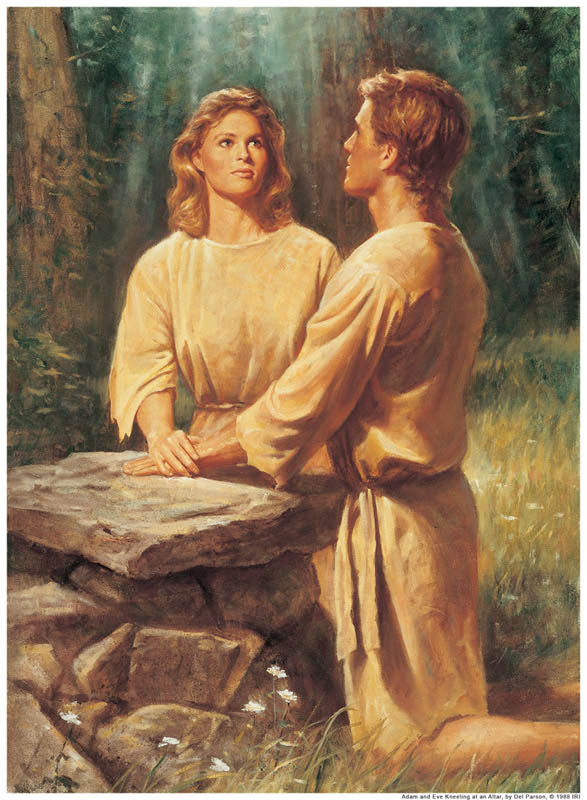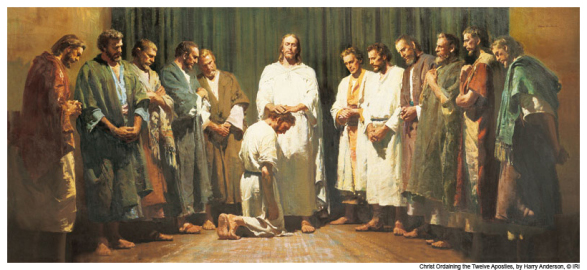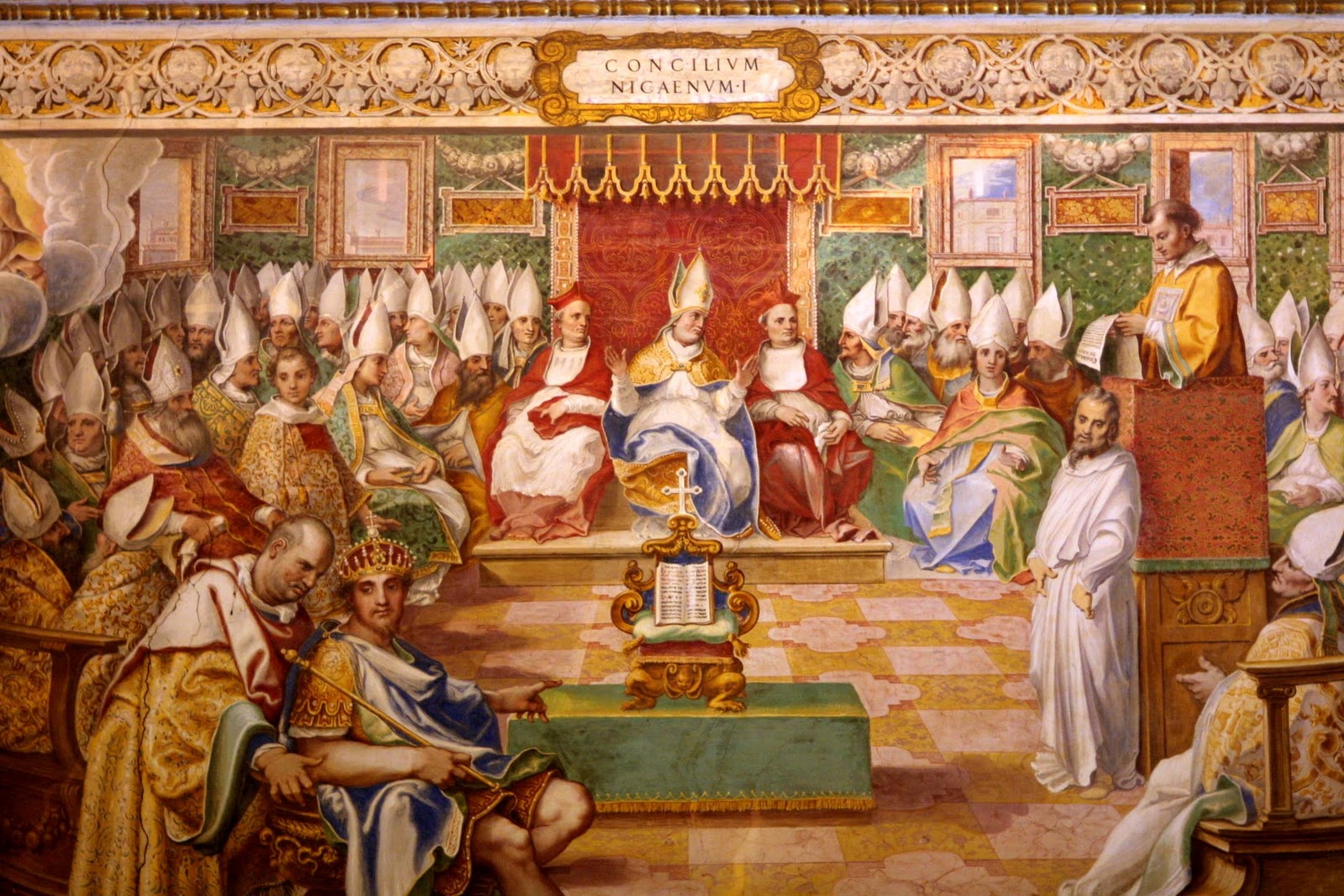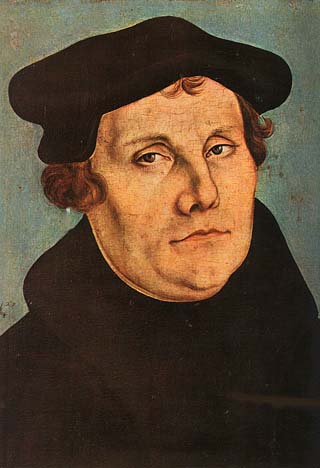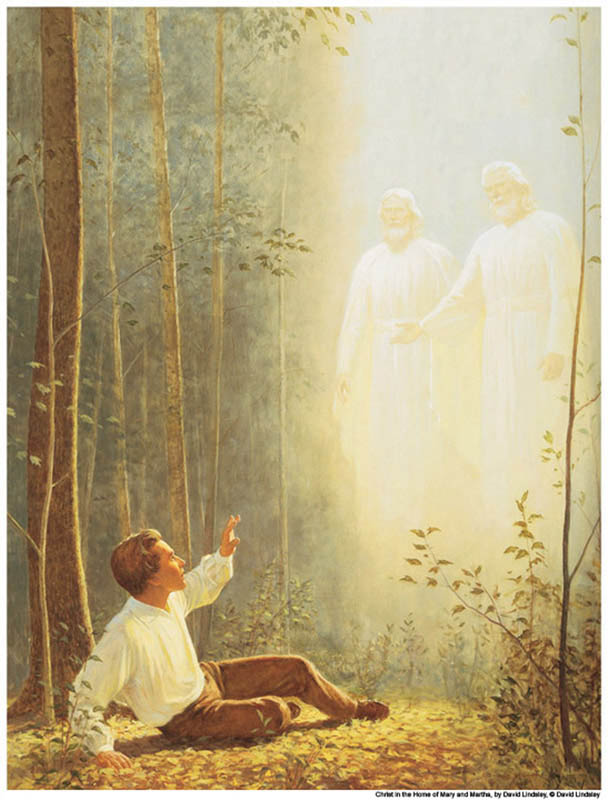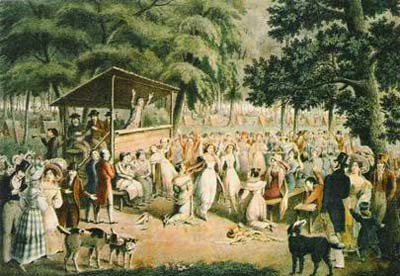Difference between revisions of "Apostasy, Reformation, and Restoration"
(→Regarding Trinitarianism) |
(→Regarding Trinitarianism) |
||
| Line 126: | Line 126: | ||
==Regarding Trinitarianism== | ==Regarding Trinitarianism== | ||
| − | [[Image:christianity_infographic. | + | [[Image:christianity_infographic.png|200px|thumb|alt=restoration of christianity|left]] |
To use the doctrine of the trinity as the qualifier for a religion to be considered Christian is patently unfair, especially since the formulation of trinitarian doctrine came not through revelation but through centuries of controversy, and cannot be certainly proven by resorting to the Bible. | To use the doctrine of the trinity as the qualifier for a religion to be considered Christian is patently unfair, especially since the formulation of trinitarian doctrine came not through revelation but through centuries of controversy, and cannot be certainly proven by resorting to the Bible. | ||
Revision as of 03:11, 19 February 2013
The religious history of the earth has been recorded by prophets and historians, theologians, and biblical scholars, and yet, the complete history will not be known until the Savior returns and reveals all things to the righteous. However, through modern revelation, more is known than ever before. The religious history of the earth shows two things: 1) that God’s plan began before the earth was created, and that He has revealed this plan to all His chosen servants, beginning with Adam; and 2) that the religious history of the earth has been a cycle of revealed information leading to covenant-making among God’s followers, and then a falling away from the truth, with increasing blindness and wickedness. Each time there has been a falling away, which we call “general apostasy,” a new dispensation has begun, led by a prophet or seer, or apostles, meant to reclaim the meek.
Contents
All the Prophets Taught of Jesus Christ
The Pearl of Great Price reveals interesting information about Adam:
- And it came to pass, when the Lord had spoken with Adam, our father, that Adam cried unto the Lord, and he was caught away by the Spirit of the Lord, and was carried down into the water, and was laid under the water, and was brought forth out of the water. And thus he was baptized, and the Spirit of God descended upon him, and thus he was born of the Spirit, and became quickened in the inner man. And he heard a voice out of heaven, saying: Thou art baptized with fire, and with the Holy Ghost. This is the record of the Father, and the Son, from henceforth and forever (Moses 6:64-66).
Later, Adam was commanded to offer sacrifice from the firstlings of his flocks. An angel appeared to him and asked him why he offered sacrifice. Adam said he knew not, except he was commanded to. The angel said,
- … This thing is a similitude of the sacrifice of the Only Begotten of the Father, which is full of grace and truth. Wherefore, thou shalt do all that thou doest in the name of the Son, and thou shalt repent and call upon God in the name of the Son forevermore. And in that day the Holy Ghost fell upon Adam, which beareth record of the Father and the Son, saying: I am the Only Begotten of the Father from the beginning, henceforth and forever, that as thou hast fallen thou mayest be redeemed, and all mankind, even as many as will. And in that day Adam blessed God and was filled, and began to prophesy concerning all the families of the earth, saying: Blessed be the name of God, for because of my transgression my eyes are opened, and in this life I shall have joy, and again in the flesh I shall see God (Moses 5:7-10).
- And our father Adam spake unto the Lord, and said: Why is it that men must repent and be baptized in water? And the Lord said unto Adam: Behold I have forgiven thee thy transgression in the Garden of Eden. Hence came the saying abroad among the people, that the Son of God hath atoned for original guilt, wherein the sins of the parents cannot be answered upon the heads of the children, for they are whole from the foundation of the world…. Wherefore, teach it unto your children, that all men, everywhere, must repent, or they can in nowise inherit the kingdom of God, for no unclean thing can dwell there, or dwell in his presence; for, in the language of Adam, Man of Holiness is his name, and the name of His Only Begotten is the Son of Man, even Jesus Christ, a righteous Judge, who shall come in the meridian of time.
- …even so ye must be born again into the kingdom of heaven, of water, and of the Spirit, and be cleansed by blood, even the blood of mine Only Begotten; that ye might be sanctified from all sin, and enjoy the words of eternal life in this world, and eternal life in the world to come, even immortal glory (Moses 6:53-54; 57, 59).
In the Book of Mormon it says,
- And now behold, Moses did not only testify of these things, but also all the holy prophets, from his days even to the days of Abraham. Yea, and behold Abraham saw of his coming, and was filled with gladness and did rejoice. Yea, and behold I say unto you, that Abraham not only knew of these things, but there were many before the days of Abraham who were called by the order of God; yea, even after the order of his Son; and this that it should be shown unto the people, a great many thousand years before his coming, that even redemption should come unto them (Helaman 8:16-18).
Thus, we see that God has always revealed His plan of redemption to His prophets, who knew thousands of years before Christ, that Jesus would be the Savior of the world. They partook of His grace anciently, and made eternal covenants in His name. God’s house is a house of order. The pattern of dispensations has continued until the present and will continue until Christ returns.
Christ Organizes His Church on the Earth
Early in His ministry, Jesus Christ called twelve apostles to lead His church on earth. He prayed all night to know God the Father’s will concerning the matter, and thus, the apostles were called by revelation (Luke 6:12). By the laying on of hands, Christ gave them power to perform miracles in His name. This power and authority is called by Latter-day Saints, “priesthood.” The new testament says that the name of Christ’s priesthood is “Melchizedek,” and that worthy saints held this priesthood under the leadership of the apostles. (See Psalm 110:4; Hebrews 2:17-18; 3:1; 5:6, 10; 6:20; 7:11, 15, 17, 21; We know that this priesthood is eternal:
- Which priesthood continueth in the church of God in all generations, and is without beginning of days or end of years. (See Doctrine and Covenants 84:6-17.)
Only one person at a time holds all the keys of the high priesthood on earth, and his authority comes from Jesus Christ. This is manner by which all God’s servants are chosen, and the power by which they serve:
- Again I say unto you, that it shall not be given to any one to go forth to preach my gospel, or to build up my church, except he be ordained by some one who has authority (Doctrine and Covenants 42:11)
- We believe that a man must be called of God, by prophecy, and by the laying on of hands by those who are in authority, to preach the Gospel and administer in the ordinances thereof (Articles of Faith 5).
This authority may be conferred by a priesthood-holder on earth who has authority, or by a heavenly messenger who has this authority. The Doctrine and Covenants says this about John the Baptist, who was ordained to the lesser, or Aaronic priesthood:
- For he was baptized while he was yet in his childhood, and was ordained by the angel of God at the time he was eight days old unto this power, to overthrow the kingdom of the Jews, and to make straight the way of the Lord before the face of His people, to prepare them for the coming of the Lord, in whose hand is given all power (Doctrine and Covenants 84:28).
Through the ages, worthy men called of God to administer His kingdom on earth have done so by revelation from Him and through the authority they received from Him.
After the death and resurrection of Christ, He spent forty days with His apostles (as a resurrected being), instructing them and preparing them to carry on the work. They would lead the church by receiving guidance through revelation, by the gift of the Holy Ghost. This is the true order of Christ’s Church. The Apostles continued to minister with power and authority resulting in the conversion of additional thousands. Through revelation Peter learned that the gospel should be taken to the Gentiles, expanding the work. The apostles spread the gospel message and established branches of the Church throughout much of the Roman Empire. As growth continued and branches multiplied, elders, bishops, deacons, priests, teachers, and evangelists (patriarchs) were called and given proper authority by the Apostles. [1]
While the Apostles and other missionaries were courageously working to establish the Lord’s kingdom on earth, the seeds of apostasy were already sprouting within the Church. Peter wrote that there were false teachers already among the people and that still others would come “who privily shall bring in damnable heresies, even denying the Lord that bought them, and bring upon themselves swift destruction” (2 Peter 2:1). Peter also predicted that “many shall follow their pernicious ways” (v. 2). Paul similarly testified that out of the congregation of believers would “men arise, speaking perverse things, to draw away disciples after them” (Acts 20:30).
The Great Apostasy
As the Apostles were killed, revelation to guide the Lord’s church ceased, along with authority to operate it. The years after the Apostles died provided ample evidence of the predicted demise of Christ’s church. Principles of the gospel were corrupted by being mixed with prevailing pagan philosophies. Loss of the Holy Spirit was evidenced by a gradual disappearance of spiritual gifts. Changes were made in church organization and government, and essential ordinances of the gospel were modified.
Neander's History of the Christian Religion and Church reports that there was an abrupt change in the writings of the early Christian church after the apostles and those with authority passed away, and men no longer led the church by direct revelation or priesthood authority.
- “…this sudden transition in the matter of excellence and trustworthiness between the writings of the Apostles and the writings of the Apostolic Fathers indicates not only a deterioration in the character of the teachers in the Church and what is taught, but more especially indicates the progress of the ‘mystery of iniquity’ which was at work subverting the Christian religion and destroying the Church of Christ” (B.H. Roberts, Introduction to The History of the Church).
Eusebius, quoting Hegesippus on the subject of false teachers and referring to the condition of the Church about the close of the first century, says:
- The Church continued until then [close of the first century] as a pure and uncorrupt virgin, whilst if there were any at all that attempted to pervert the sound doctrine of the saving Gospel, they were yet skulking in dark retreats: but when the sacred choir of Apostles became extinct, and the generation of those that had been privileged to hear their inspired wisdom had passed away, then also the combinations of impious errors arose by the fraud and delusions of false teachers. These also, as there were none of the Apostles left, henceforth attempted without shame, to preach their false doctrine against the gospel of truth.
During this time, Christians at all levels of authority participated in plagiarism and fraud, so early Christian writings are muddled, as must have been oral tradition. The early church fathers censured each other, while some held true ideas and were censured. For example, Papias, a Bishop and Christian Father in the second century, was condemned by Eusebius for saying that he received from Apostolic men, meaning thereby men who were associated with the Apostles, the fact that there would be a corporeal reign of Christ on earth with the saints, after the resurrection, which would continue through a thousand years. Nearly all Christian faiths now believe that Papias was correct — Christ will rule during the millennium, ushered in by His Second Coming.
- And so throughout there is censure and counter censure between the orthodox and the heretics, and it is difficult at times to determine which are the orthodox and which heretics, so frequently do they change places. Nor was there any improvement in the ages that succeeded these that have been briefly considered. The editor of Dr. Jortin's learned work on ecclesiastical history, William Trollope, on a passage of Jortin's on the early fathers, says of the fathers of the fourth century:
- After the council of Nice, a class of writers sprang up, greatly inferior to their predecessors, in whatever light their pretensions are viewed. Sadly deficient in learning, prejudiced in opinion, and inelegant in style, they cannot be admitted for a moment into competition with those who were contemporary with the Apostles and their immediate successors (B.H. Roberts, Introduction to The History of the Church).
The church that Christ and the apostles established was led by revelation and authority. People were called from their normal worldly professions to volunteer in the service of the Saints, and many were commended for their service in the New Testament epistles. Hundreds of years later orthodoxy had a professional clergy, and high offices were often bought (Medici Popes); the papal army was not averse to killing those who offended the Pope (the drive into Florence; later the crusades and inquisitions). Other corruptions of original doctrine and practice included the idea of original sin leading to infant baptism (Christ’s doctrine is that babes are born in innocence – see Moroni 8:8-16); the high esteem of celibacy for God’s servants; the withholding of scripture from the populace; praying to "Saints," and the selling of indulgences — the forgiveness of sin for money. Lost also was the God of the Bible, our Heavenly Father, separate from the Son, at whose right hand the Savior stands and has been seen in vision.
The Reformation
The selling of indulgences was the final straw for Martin Luther. The Medici Popes had financed their way into religious leadership, but the Church was in financial trouble by this time. The selling of salvation, first for believers, and then for their dead, was a way to get funds, but doctrinally appalling to Luther, whose 95 Theses dealt mainly with the faulty doctrine behind the practice. There was a movement afoot in Europe, as courageous biblical scholars translated the Bible from Latin to vernacular languages. Along with getting the scriptures into the hands of the people was the idea that people could read them and understand through the Holy Spirit what the scriptures said and meant. This was dangerous to the Catholic Church, and persecution of “protestant” sects became commonplace.
Many of the early settlers in America were protestants fleeing persecution in Europe. The Massachusetts Bay Colony was established by English Puritans (Congregationalists), Pennsylvania by British Quakers, and Virginia by English Anglicans. Freedom of religion became of central importance in the early United States. The United States was the first nation to have no official state-endorsed religion. The reformation, accompanied by the Enlightenment and God’s blessings created a foundational leadership suited to draft an inspired constitution.
- "…According to the laws and constitution of the people, which I have suffered to be established, and should be maintained for the rights and protection of all flesh, according to just and holy principles…. Therefore, it is not right that any man should be in bondage one to another. And for this purpose I have established the Constitution of this land, by the hands of wise men whom I have raised up unto this very purpose, and redeemed the land by the shedding of blood (Doctrine and Covenants 101:77, 79, 80).
- “The framers of the Constitution rejected any religious test for office, and the First Amendment specifically denied the federal government any power to enact any law respecting either an establishment of religion or prohibiting its free exercise, thus protecting any religious organization, institution, or denomination from government interference. The decision was mainly influenced by European Rationalist and Protestant ideals, but was also a consequence of the pragmatic concerns of minority religious groups and small states that did not want to be under the power or influence of a national religion that did not represent them.” [1]
Christian protestant religions multiplied, and many different sects were found in early America.
- “During the 'Great Awakenings' interdenominational evangelicalism and Pentecostalism emerged, along with new Protestant denominations such as Adventism, and non-Protestant movements such as the Restoration Movement (which over time separated into the Churches of Christ, the Christian churches and churches of Christ, and the Christian Church (Disciples of Christ)), the Watchtower Bible and Tract Society, commonly referred to as Jehovah's Witnesses.” [2]
The Restoration
In 1820 in New England the Second Great Awakening was underway. Religious fervor was at its peak, and the various sects of Christianity held revivals and tent meetings, vying for converts. Joseph Smith was then fourteen years old, the son of an impoverished farm family. They were devout Christians, but unaffiliated at the time. They attended tent meetings whenever their farm work would allow. Part of the family had converted to Presbyterianism, and other family members were drawn to Methodism. Joseph, however, grew more and more confused. Really, the only authority he could resort to was the Bible:
- While I was laboring under the extreme difficulties caused by the contests of these parties of religionists, I was one day reading the Epistle of James, first chapter and fifth verse, which reads: If any of you lack wisdom, let him ask of God, that giveth to all men liberally, and upbraideth not; and it shall be given him.
- Never did any passage of scripture come with more power to the heart of man than this did at this time to mine. It seemed to enter with great force into every feeling of my heart. I reflected on it again and again, knowing that if any person needed wisdom from God, I did; for how to act I did not know, and unless I could get more wisdom than I then had, I would never know; for the teachers of religion of the different sects understood the same passages of scripture so differently as to destroy all confidence in settling the question by an appeal to the Bible.
- At length I came to the conclusion that I must either remain in darkness and confusion, or else I must do as James directs, that is, ask of God. I at length came to the determination to “ask of God,” concluding that if he gave wisdom to them that lacked wisdom, and would give liberally, and not upbraid, I might venture (Joseph Smith History 1:11-13).
Joseph resorted to a grove of trees found on his parents’ property and ventured to pray aloud to God. His only desire was to get an answer to his question — which church should he join. As soon as he began to pray, he was nearly destroyed by an unseen, but very real, dark force. Calling upon God, he was rescued:
- …just at this moment of great alarm, I saw a pillar of light exactly over my head, above the brightness of the sun, which descended gradually until it fell upon me. It no sooner appeared than I found myself delivered from the enemy which held me bound. When the light rested upon me I saw two Personages, whose brightness and glory defy all description, standing above me in the air. One of them spake unto me, calling me by name and said, pointing to the other—This is My Beloved Son. Hear Him! (Joseph Smith History 1:16, 17.)
When he overcame his fear, Joseph asked his question and he received an answer:
- I was answered that I must join none of them, for they were all wrong; and the Personage who addressed me said that all their creeds were an abomination in his sight; that those professors were all corrupt; that: “they draw near to me with their lips, but their hearts are far from me, they teach for doctrines the commandments of men, having a form of godliness, but they deny the power thereof.”
- He again forbade me to join with any of them; and many other things did he say unto me, which I cannot write at this time. When I came to myself again, I found myself lying on my back, looking up into heaven. When the light had departed, I had no strength (JSH 1:19, 20)….
The creeds, commonly shared by both orthodox and protestant churches, centered upon defining the nature of God. Over hundreds of years the formulation came to be called the concept of “trinity” — three beings of one substance, usually with Christ coming to earth as God incarnate. The appearance of two glorious resurrected beings in vision to Joseph Smith put the lie to that doctrine and led to his severe persecution and eventual martyrdom at the age of thirty-nine. That the existing churches might have “a form of godliness, but …deny the power thereof” refers mostly to their lack of the power and authority to teach, administer, and perform ordinances in the name of Christ.
Joseph continued to be taught by heavenly messengers, as God chose him to be the first prophet of the restoration of Christ’s primitive church in preparation for the Second Coming of Christ and ushering in of His millennial reign. Joseph was given the lesser, or Aaronic, priesthood by the resurrected John the Baptist, and ordained to the higher, or Melchizedek, priesthood by Peter, James, and John. Heavenly messengers revealed to Joseph Smith the location of a collection of scripture, which he (an unlearned young man) translated by the power of God. It was published as the Book of Mormon: Another Testament of Jesus Christ. Other translations of lost scripture, and collections of modern revelations were added to the open canon of The Church of Jesus Christ of Latter-day Saints. Joseph Smith has been succeeded by a series of prophets, seers, and revelators, leading the restored gospel of Jesus Christ — the kingdom of God on earth. The LDS Church is organized as Christ’s primitive church, with apostles, seventies, etc., and as existed in the primitive church, a lay clergy led by inspiration through the Holy Ghost. It is the only true and living church of Christ on the earth.
Many Had Sought a Restoration of Christ’s Primitive Church
The restoration movement was a Christian movement that began on the American frontier during the Second Great Awakening of the early 19th century, but which had its roots in the very early days of the Reformation. Early reformation dissenters such as John Wycliff and John Huss called for a restoration of a primitive form of Christianity, but they were driven underground. The movement sought to restore the church and "the unification of all Christians in a single body patterned after the church of the New Testament." They did not consider themselves Protestant. The Restoration Movement developed from several independent efforts to return to apostolic Christianity. [3]
The groups promoted a return to the purposes of the 1st-century churches as described in the New Testament. One of the basic goals of the English Puritans was to restore a pure, "primitive" church that would be a true apostolic community. None of these churches, however, could return to a true apostolic community without the restoration of Christ’s authority and power held by the primitive apostles.
Early on, missionaries of The Church of Jesus Christ of Latter-day Saints set out to spread the word that Christ’s primitive church had been restored. Venturing westward, Mormon missionaries taught Indians in western Ohio and then people who were restorationists:
- Sidney Rigdon was a prominent minister in the area who presided over a group of seekers (people seeking a return to New Testament Christianity). At one time Sidney merged his interests with those of another seeker, Alexander Campbell, and helped found the church called the Disciples of Christ, also known as the Campbellites. But Rigdon disagreed with Campbell on certain doctrinal practices and formed his own group, the Reformed Baptist Society. Because of his former close associations with Rigdon, Elder Parley P. Pratt convinced his companions to visit Sidney in Mentor, Ohio, where he testified to his former teacher that the Restoration had occurred, including the restoration of divine authority. Oliver Cowdery, an eyewitness to the restoration of the priesthood, bore firsthand testimony of that event.
- Although Sidney treated the missionaries cordially and with respect, his was no instantaneous conversion. He told the elders, “I will read your book, and see what claims it has upon my faith.” The elders then asked to present their message in Rigdon’s church. Consent was given, “the appointment was accordingly published, and a large and respectable congregation assembled.” At the end of the meeting, Rigdon, with commendable open-mindedness, told his listeners that the message they had just heard “was of an extraordinary character, and certainly demanded their most serious consideration.” He reminded the congregation of the Apostle Paul’s advice to “prove all things; hold fast that which is good” (1 Thessalonians 5:21).
- Meanwhile, the elders were not idle. Less than five miles from Rigdon’s home in Mentor was the village of Kirtland, where numerous members of Sidney’s congregation lived. The missionaries preached from house to house, likewise receiving respectful attention. Soon some residents were convinced that no one among them possessed the divine authority necessary to administer gospel ordinances and that they had not been authoritatively baptized themselves. After much study and prayer, many people, including Sidney Rigdon, requested baptism at the hands of the missionaries.
- News of their teachings spread rapidly. Parley P. Pratt reported, “The people thronged us night and day, insomuch that we had no time for rest and retirement. Meetings were convened in different neighborhoods, and multitudes came together soliciting our attendance; while thousands flocked about us daily; some to be taught, some for curiosity, some to obey the gospel, and some to dispute or resist it.” Within three weeks of the missionaries’ arrival, 127 persons were baptized. [4] [2]
Regarding Trinitarianism
To use the doctrine of the trinity as the qualifier for a religion to be considered Christian is patently unfair, especially since the formulation of trinitarian doctrine came not through revelation but through centuries of controversy, and cannot be certainly proven by resorting to the Bible.
- “The exact theological definition of the doctrine of the Trinity,” notes J. R. Dummelow, “was the result of a long process of development, which was not complete until the fifth century, or maybe even later.” As Bill Forrest remarks, “To insist that a belief in the Trinity is requisite to being Christian, is to acknowledge that for centuries after the New Testament was completed thousands of Jesus’ followers were in fact not really ‘Christian.’” [5] [3]
Mormons also cite Biblical script to support their position that God the Father, Jesus Christ and the Holy Ghost are actually three distinct beings, one in purpose, the “Godhead.” ( See in the Authorized King James Version: John 20:17; Acts 7:55-56; John 17:5,11,20-26; Matt 3:13-17; Mark 1:9-11; Luke 3:21-22.)
References
- ↑ Wikipedia: Religion in the United States
- ↑ Wikipedia: Religion in the United States
- ↑ Wikipedia:Restoration Movement
- ↑ Church History in the Fullness of Times, Chapter 7.
- ↑ Cited by Bill Forrest, “Are Mormons Christians?” Mormon Miscellaneous Response Series (Salt Lake City: Mormon Miscellaneous, n.d.).
